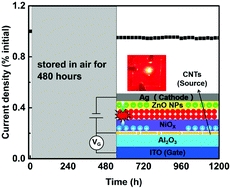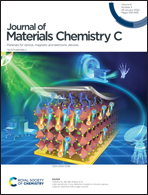Gate-tunable all-inorganic QLED with enhanced charge injection balance†
Abstract
All-inorganic quantum-dot light emitting diodes (QLEDs) have attracted much attention due to their high stability. The main challenge in an all-inorganic QLED is that the hole mobility of the inorganic hole transport layer (HTL) is significantly lower than the electron mobility of the inorganic electron transport layer (ETL) which causes unbalanced charge injection and subsequent low performance. To address this issue, a novel gate-tunable all-inorganic QLED is proposed, where the additional gate electrode is able to modulate the hole injection ability and then precisely tune the charge balance in the QLED, resulting in the suppression of Auger recombination and a subsequent significant improvement in device performance. Finally, the all-inorganic QLEDs exhibit high performance with a maximum current efficiency (CE) of 14.2 cd A−1 and an external quantum efficiency (EQE) of 10.7% along with high stability. The realization of long lifetime and high performance with our proposed device structure opens up new avenues for expanding the commercial applications of QLEDs. More importantly, this strategy is broadly applicable to various QLED systems to modulate the charge injection balance for further improvement in the device performance of QLEDs.



 Please wait while we load your content...
Please wait while we load your content...